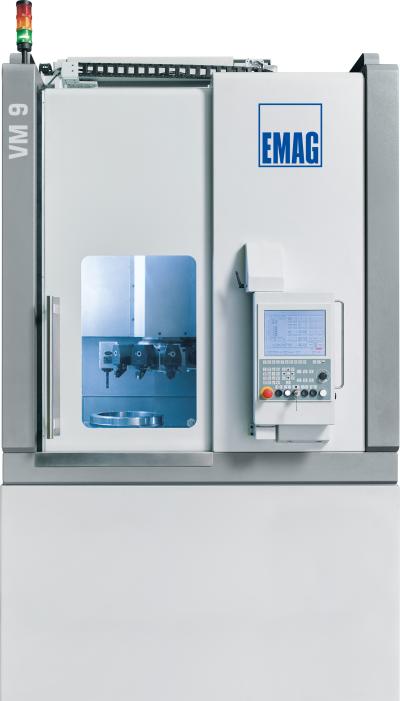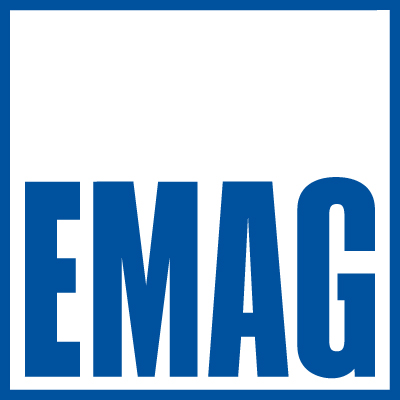
With the new VM 9 modular turning machine, EMAG has introduced a platform that covers a broad spectrum of applications thanks to the combined turning, milling and drilling technologies and intelligent machine design. The highly accessible machining area and workpiece spindle fitted at the bottom ensure short tooling times and maximum flexibility in the production of workpieces in small series.
The VM 9 vertical turning center is designed for the manufacture of individual parts and small production runs with a wide variety of parts. The heavy-duty foundation of the machine is made of a MINERALIT polymer concrete column. The particularly good damping properties of MINERALIT, combined with the compound slide with the X- and Z-axes ensure excellent machining quality, high speed processes and short idle times. The main spindle provides the necessary power with a 83 kW rating and a torque of 990 Nm.
Part of the large family of EMAG modular machines, the VM 9 is designed as a vertical turning center, combining a reliable design with an extensive range of equipment. Designed to machine chucked components with a maximum diameter up to 450 mm, it features a tool turret which can be fitted with up to twelve tool positions, depending on the tool interface (BMT or VDI). The turret can, of course, be equipped with driven tools to carry out drilling or milling operations, for example. The integrated probe delivers absolute process reliability by ensuring continuous quality control of the workpieces. Thus, the VM 9 is thus extremely well equipped for a wide variety of production tasks, enabling it to produce a wide range of workpiece formats.
But the VM 9 does not just deliver enhanced machining quality. The ergonomic design of the machines is evidence of the decades of experience EMAG has with vertical turning machines. Both the machining area and all maintenance components are easy to access. “This is the really positive aspect of the VM 9 for our customers,” explains Peter Loetzner, CEO EMAG LLC. “It is a major advantage for customers who have to machine many different workpieces or various part families.”
With the VM 9, EMAG offers a new machine system for chucked parts suited to the production of a variety of workpieces in many different manufacturing scenarios thanks to its flexibility. Whether components for trucks, construction and agricultural machines or for mechanical and plant engineering, the VM 9 is ideal for practically every sector. The excellent accessibility to the machining area makes the machines an all-round solution for turned parts.
Contact Details
Related Glossary Terms
- gang cutting ( milling)
gang cutting ( milling)
Machining with several cutters mounted on a single arbor, generally for simultaneous cutting.
- milling
milling
Machining operation in which metal or other material is removed by applying power to a rotating cutter. In vertical milling, the cutting tool is mounted vertically on the spindle. In horizontal milling, the cutting tool is mounted horizontally, either directly on the spindle or on an arbor. Horizontal milling is further broken down into conventional milling, where the cutter rotates opposite the direction of feed, or “up” into the workpiece; and climb milling, where the cutter rotates in the direction of feed, or “down” into the workpiece. Milling operations include plane or surface milling, endmilling, facemilling, angle milling, form milling and profiling.
- quality assurance ( quality control)
quality assurance ( quality control)
Terms denoting a formal program for monitoring product quality. The denotations are the same, but QC typically connotes a more traditional postmachining inspection system, while QA implies a more comprehensive approach, with emphasis on “total quality,” broad quality principles, statistical process control and other statistical methods.
- turning
turning
Workpiece is held in a chuck, mounted on a face plate or secured between centers and rotated while a cutting tool, normally a single-point tool, is fed into it along its periphery or across its end or face. Takes the form of straight turning (cutting along the periphery of the workpiece); taper turning (creating a taper); step turning (turning different-size diameters on the same work); chamfering (beveling an edge or shoulder); facing (cutting on an end); turning threads (usually external but can be internal); roughing (high-volume metal removal); and finishing (final light cuts). Performed on lathes, turning centers, chucking machines, automatic screw machines and similar machines.
- turning machine
turning machine
Any machine that rotates a workpiece while feeding a cutting tool into it. See lathe.

